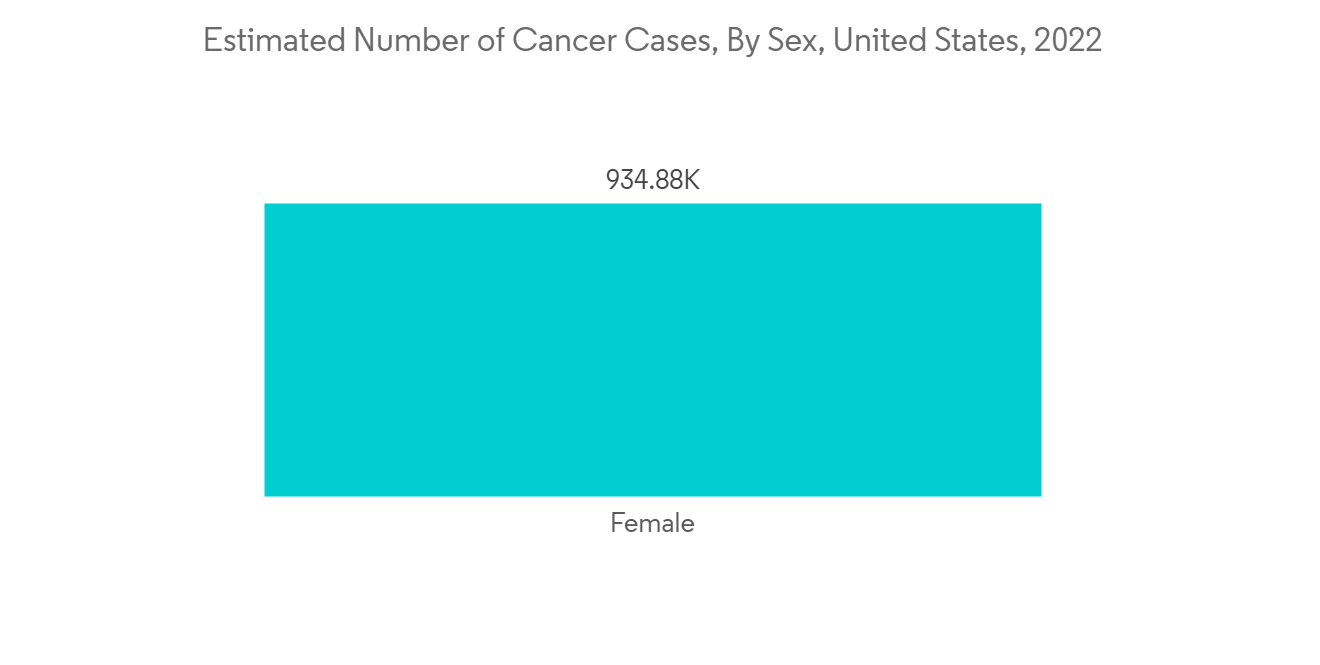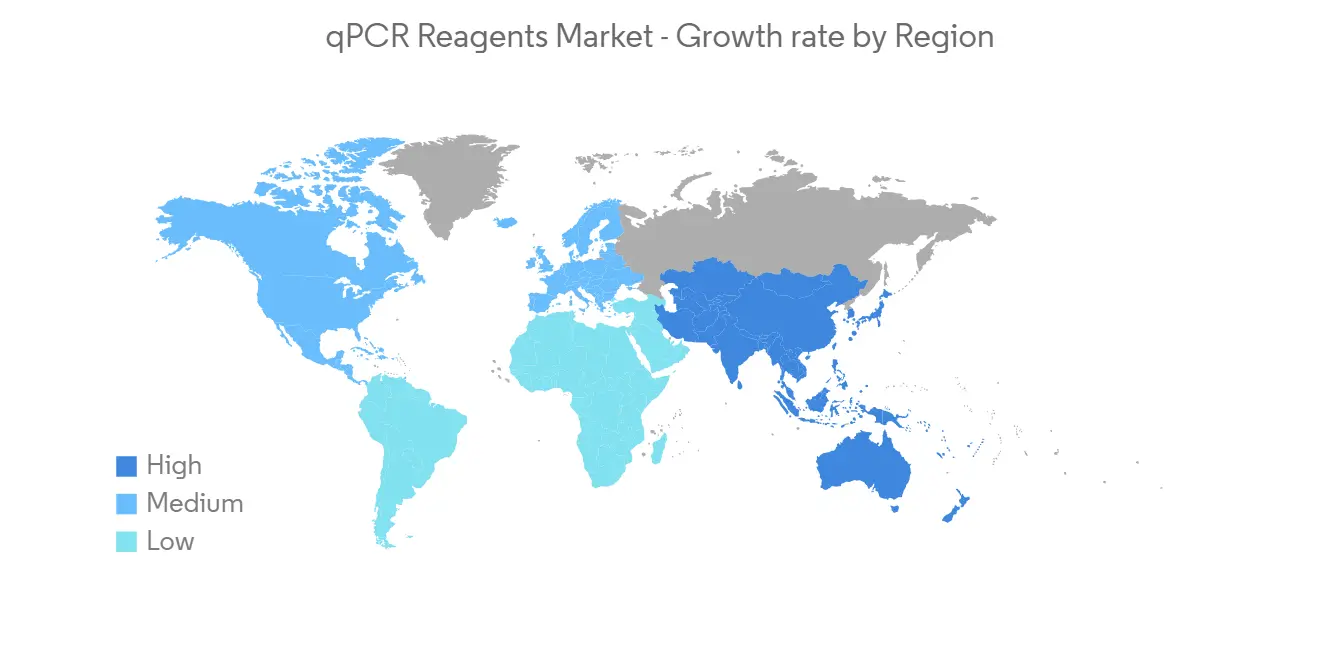PUBLISHER: Mordor Intelligence | PRODUCT CODE: 1273447

PUBLISHER: Mordor Intelligence | PRODUCT CODE: 1273447
qPCR Reagents Market - Growth, Trends, and Forecasts (2023 - 2028)
The qPCR reagents market is expected to register a CAGR of 7.9% over the forecast period.
The market for qPCR reagent products has increased as a result of COVID-19, owing mostly to rising demand for polymerase chain reaction tests and a significant increase in the target patient group. The qPCR test, which uses nasopharyngeal swabs or other upper respiratory tract specimens, such as throat swabs or, more recently, saliva for immunology assays, has been the most commonly used and reliable test for COVID-19 diagnosis. As a result, disease diagnosis utilizing qPCR reagents emerged as a primary emphasis for pandemic management. The press release by Cytiva in May 2021 revealed that a qPCR reagent manufacturing company had to immediately raise output 50-fold to satisfy the demand for COVID-19 tests. Thus, during the pandemic, the demand for qPCR reagents tremendously increased, which positively influenced the market's growth. Currently, the market demand has slowed down as the number of COVID-19 has declined. Moreover, it is expected that the market will grow over the forecast period due to the rise in the prevalence of chronic diseases and technological advances in the qPCR test.
The rising incidence of infectious and genetic diseases has increased the demand for diagnostic tests that may help people take precautionary measures. The growing geriatric population has also increased the demand for genetic tests. For instance, according to the Breast Cancer Factsheet Now 2021, around 55,000 women and 370 men in the United Kingdom are diagnosed with breast cancer yearly. Breast cancer has claimed the lives of an estimated 600,000 people in the United Kingdom. This figure is expected to climb to 1.2 million by 2030. Additionally, according to the Australian Federation of AIDS Organizations Report published in November 2022, in 2021, it was estimated that there were 29,460 people with HIV in Australia. Of these 29,460 people, an estimated 91% will have been diagnosed by the end of 2021. Thus, with the growing prevalence of infectious diseases, the demand for diagnostic tests is expected to increase, which propels the growth of the market over the forecast period.
Moreover, the growing geriatric population is expected to support market expansion as this population is more susceptible to infectious and chronic diseases. The increasing geriatric population is likely to increase market growth over the forecast period. For instance, according to the 2022 statistics published by the United Nations Population Fund, in the United States, a large proportion of the living population is aged 15-64 and accounts for 65% in 2022. Furthermore, according to the same source, 17% of the population will be 65 or older in 2022. Thus, infectious diseases are more prevalent in the geriatric population, boosting the demand for qPCR reagents.
Thus, the growing burden of infectious diseases and the ageing population support market expansion over the forecast period. However, the high cost of qPCR equipment and the lack of high technical expertise to operate qPCR equipment have been restraining market growth.
qPCR Reagents Market Trends
Dye-Based qPCR Reagents are Expected to Dominate the Market
The use of fluorescent DNA-binding dyes is one of the most straightforward and common qPCR approaches used by scientists. A dye is added to the reaction, and fluorescence is measured at each PCR cycle. Because the fluorescence of these dyes increases dramatically in the presence of double-stranded DNA, DNA synthesis can be monitored as an increase in fluorescent signal.
Dye-based diagnostic qualitative PCR is applied to rapidly detect nucleic acids that are diagnostic of, for example, infectious diseases, cancer, and genetic abnormalities. For instance, according to the Breast Cancer Factsheet Now 2021, around 55,000 women and 370 men in the United Kingdom are diagnosed with breast cancer yearly. Breast cancer has claimed the lives of an estimated 600,000 people in the United Kingdom. This figure is expected to climb to 1.2 million by 2030. Thus, the growing burden of cancer diseases is expected to propel the segment's growth.
Additionally, product launches by the market players are expected to support the market expansion over the forecast period. For instance, in December 2021, Biotium released 'EvaRuby' Dye for qPCR and HRM. This spectrally unique red fluorescent intercalating dye can be incorporated into probe-based qPCR assays, expanding multiplexing options for probe-based qPCR. EvaRuby Dye is compatible with ~470 nm excitation and ~610 nm emission filters.
Thus, all aforementioned factors with product launches are expected to boost segment growth over the forecast period.

North America is Expected to Hold a Significant Market Share Over the Forecast Period
North America holds the major market share in the PCR reagent market. The rising incidence of diseases, the elderly population (aging), and technological advancements are attributed to market growth. Especially in recent times, pandemics have also boosted the qPCR reagent market. For instance, according to Cancer Facts and Figures 2022, published in January 2022 by the American Cancer Society, an estimated 1.9 million new cancer cases will be diagnosed in 2022, among which prostate cancer is estimated to be 186,670, followed by 169,870 cases of lung cancer, and 144,490 cases of female breast cancer. The increased prevalence of cancer and the high burden of other chronic diseases increase the demand for accurate diagnosis and treatment. This is likely to increase the qPCR reagent, ultimately boosting the market growth.
Furthermore, according to statistics published by the Government of Canada and released in November 2021, about 229,200 Canadians were diagnosed with cancer in 2021, and prostate cancer is expected to remain the most diagnosed cancer, accounting for 46% of all cancer diagnoses in 2021. According to the same source, breast cancer affects one out of every eight women at some point in their lives. Thus, as the number of cancer cases rises, so does the demand for early diagnosis, driving demand for qPCR reagents over the projection period.
Additionally, product launches by the market players are expected to support market growth. For instance, in February 2022, New England Biolabs (NEB) released the LyoPrime Luna Probe One-Step RT-qPCR Mix with UDG, its first lyophilized product manufactured by Fluorogenics. This lyophilized master mix has the same adaptable characteristics and strong performance as the previously published liquid 4X mix, allowing for sensitive, linear real-time detection of target RNA sequences in a room temperature-stable format.
Thus, all aforementioned factors, such as the growing burden of infectious diseases, are expected to boost the growth of the market in the region.

qPCR Reagents Industry Overview
The qPCR reagents market is highly competitive and consists of a few major players. Market leaders with more funds for research and better distribution system have established their position in the market. The key Companies in this market are F. Hoffman-La Roche Ltd, Agilent Technologies, Bio-Rad Laboratories Inc, Merck KGaA (Sigma Aldrich Corporation), and Thermo Fisher Scientific Inc.
Additional Benefits:
- The market estimate (ME) sheet in Excel format
- 3 months of analyst support
TABLE OF CONTENTS
1 INTRODUCTION
- 1.1 Study Assumptions and Market Definition
- 1.2 Scope of the Study
2 RESEARCH METHODOLOGY
3 EXECUTIVE SUMMARY
4 MARKET DYNAMICS
- 4.1 Market Overview
- 4.2 Market Drivers
- 4.2.1 Rising Incidence of Infectious Diseases and Genetic Disorders
- 4.2.2 Growing Geriatric Population
- 4.2.3 Increasing Focus on Human Genome Projects
- 4.3 Market Restraints
- 4.3.1 High Cost of Reagents and qPCR Equipment
- 4.3.2 Lack of Technical Expertise to Operate the qPCR instrument
- 4.4 Porter Five Forces
- 4.4.1 Threat of New Entrants
- 4.4.2 Bargaining Power of Buyers/Consumers
- 4.4.3 Bargaining Power of Suppliers
- 4.4.4 Threat of Substitute Products
- 4.4.5 Intensity of Competitive Rivalry
5 MARKET SEGMENTATION (Market Size by Value - in USD Millions)
- 5.1 By Detection Method
- 5.1.1 Dye-Based qPCR Reagents
- 5.1.2 Probes and Primer-Based qPCR Reagents
- 5.2 By Packaging Type
- 5.2.1 qPCR Core Kits
- 5.2.2 qPCR Mastermixes
- 5.3 By End-User
- 5.3.1 Hospitals & Diagnostic Centers
- 5.3.2 Research Laboratories & Academic Institutes
- 5.3.3 Others
- 5.4 Geography
- 5.4.1 North America
- 5.4.1.1 United States
- 5.4.1.2 Canada
- 5.4.1.3 Mexico
- 5.4.2 Europe
- 5.4.2.1 Germany
- 5.4.2.2 United Kingdom
- 5.4.2.3 France
- 5.4.2.4 Italy
- 5.4.2.5 Spain
- 5.4.2.6 Rest of Europe
- 5.4.3 Asia-Pacific
- 5.4.3.1 China
- 5.4.3.2 Japan
- 5.4.3.3 India
- 5.4.3.4 Australia
- 5.4.3.5 South Korea
- 5.4.3.6 Rest of Asia-Pacific
- 5.4.4 Middle-East and Africa
- 5.4.4.1 GCC
- 5.4.4.2 South Africa
- 5.4.4.3 Rest of Middle-East and Africa
- 5.4.5 South America
- 5.4.5.1 Brazil
- 5.4.5.2 Argentina
- 5.4.5.3 Rest of South America
- 5.4.1 North America
6 COMPETITIVE LANDSCAPE
- 6.1 Company Profiles
- 6.1.1 Kaneka Eurogentec S.A.
- 6.1.2 Agilent Technologies, Inc.
- 6.1.3 Bio-Rad Laboratories, Inc.
- 6.1.4 F. Hoffman-La Roche Ltd.
- 6.1.5 Promega Corporation
- 6.1.6 Quanta Biosciences, Inc.
- 6.1.7 Sigma-Aldrich Corporation (Merck KGaA)
- 6.1.8 Takara Bio Inc.
- 6.1.9 Thermo Fisher Scientific
7 MARKET OPPORTUNITIES AND FUTURE TRENDS




